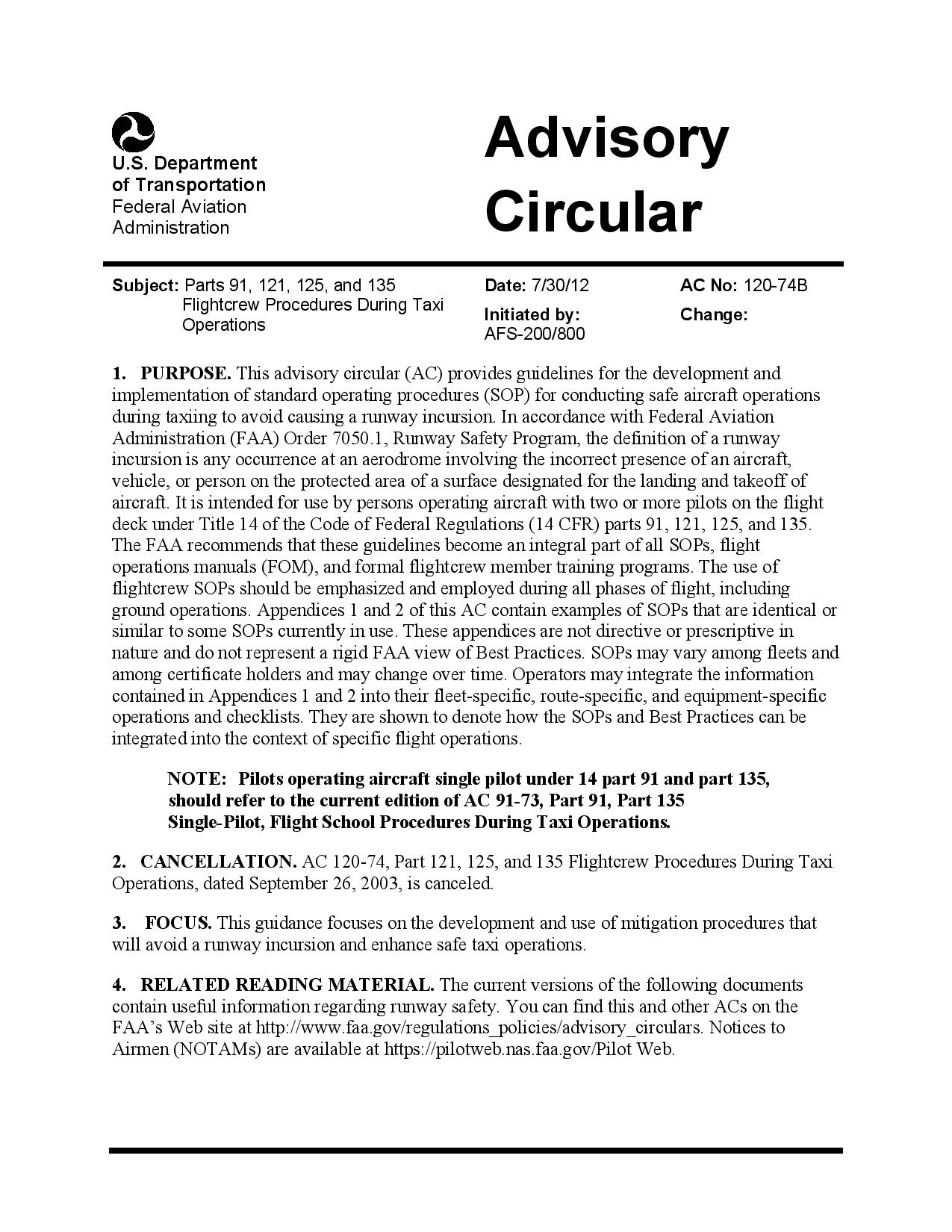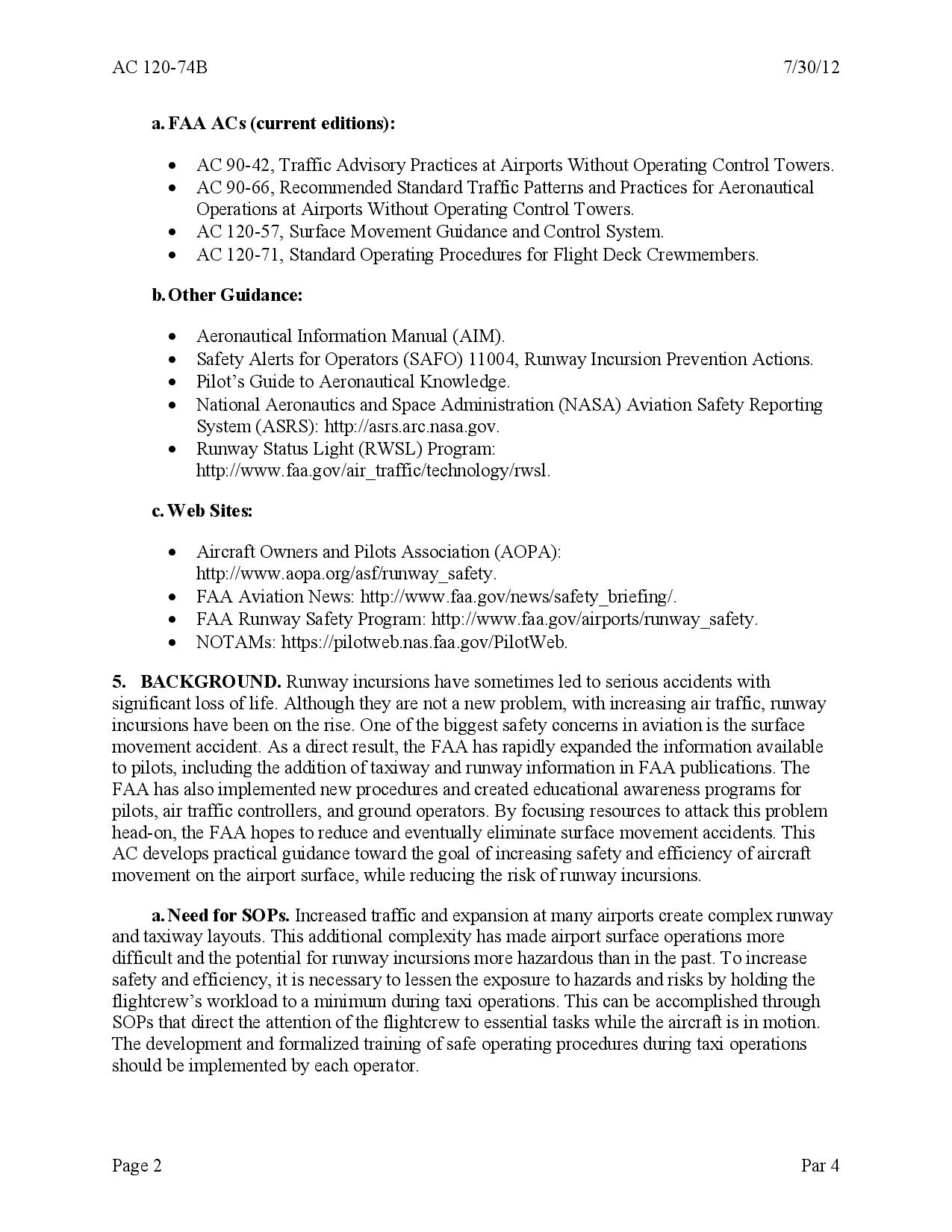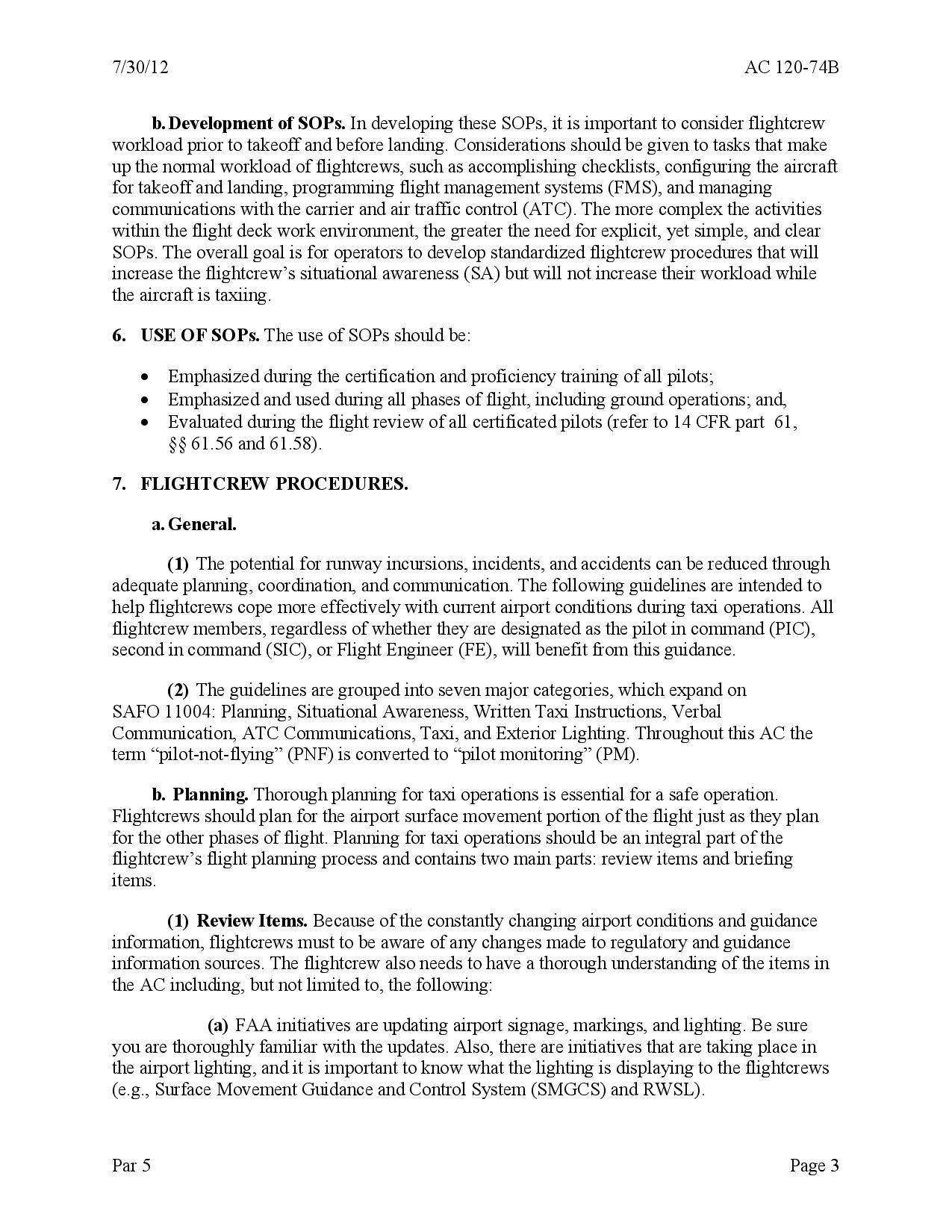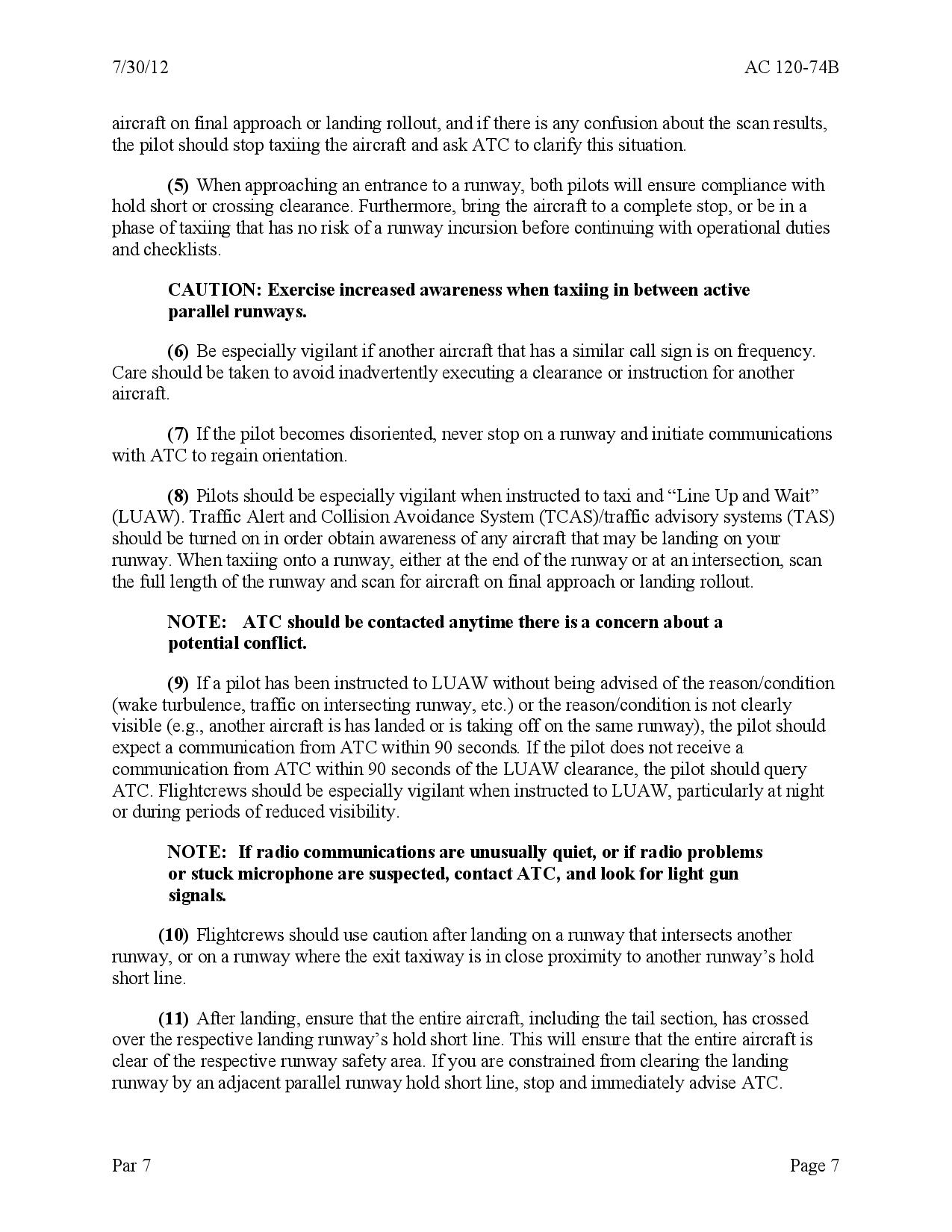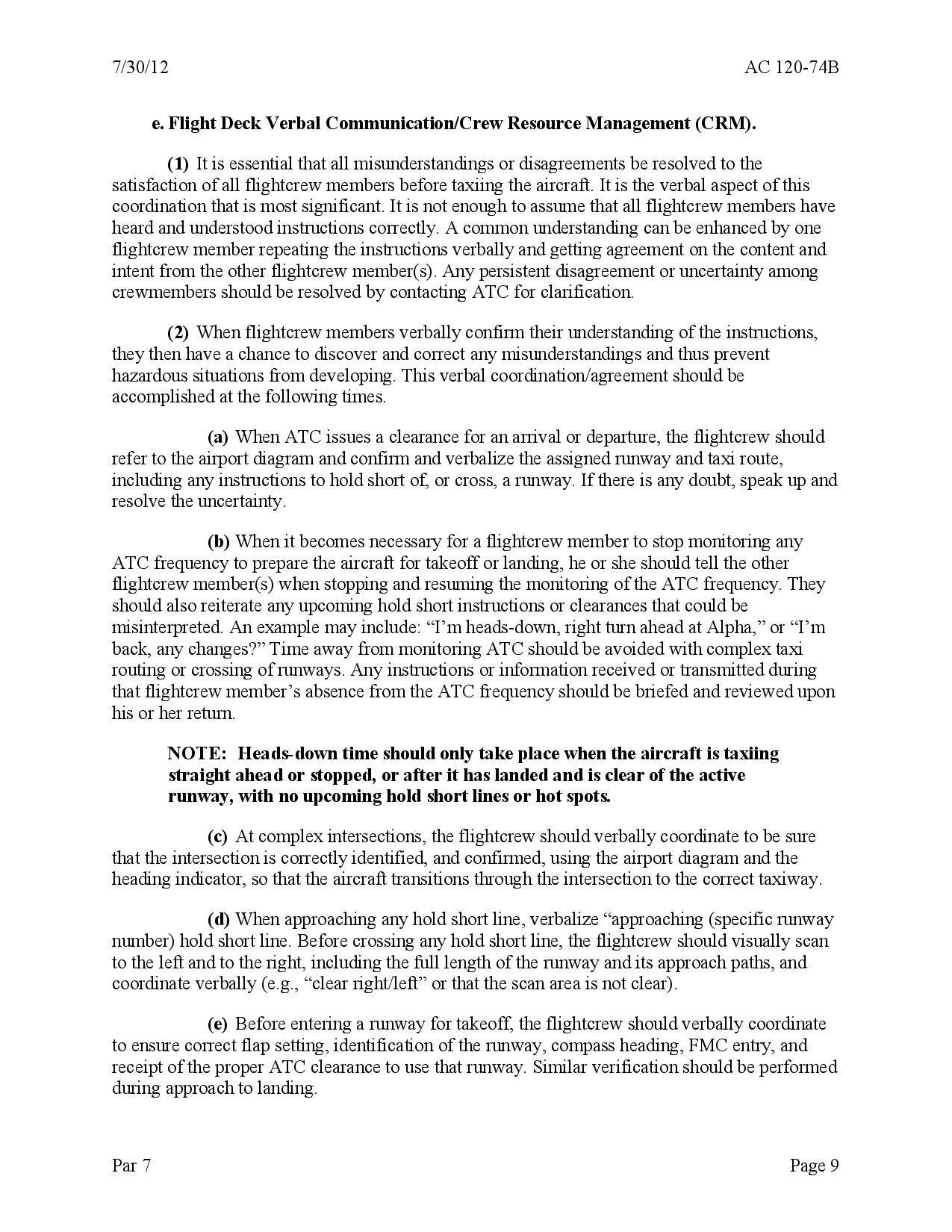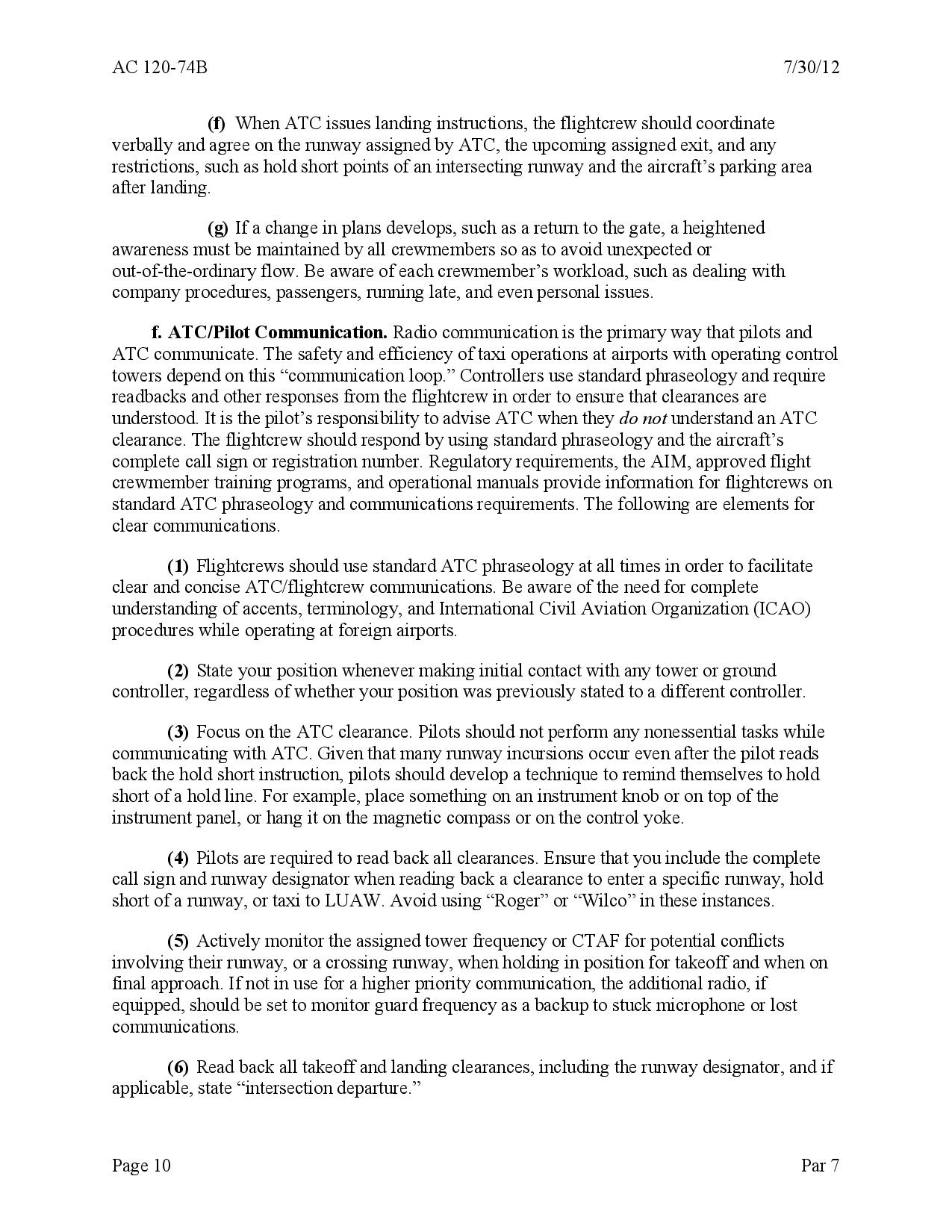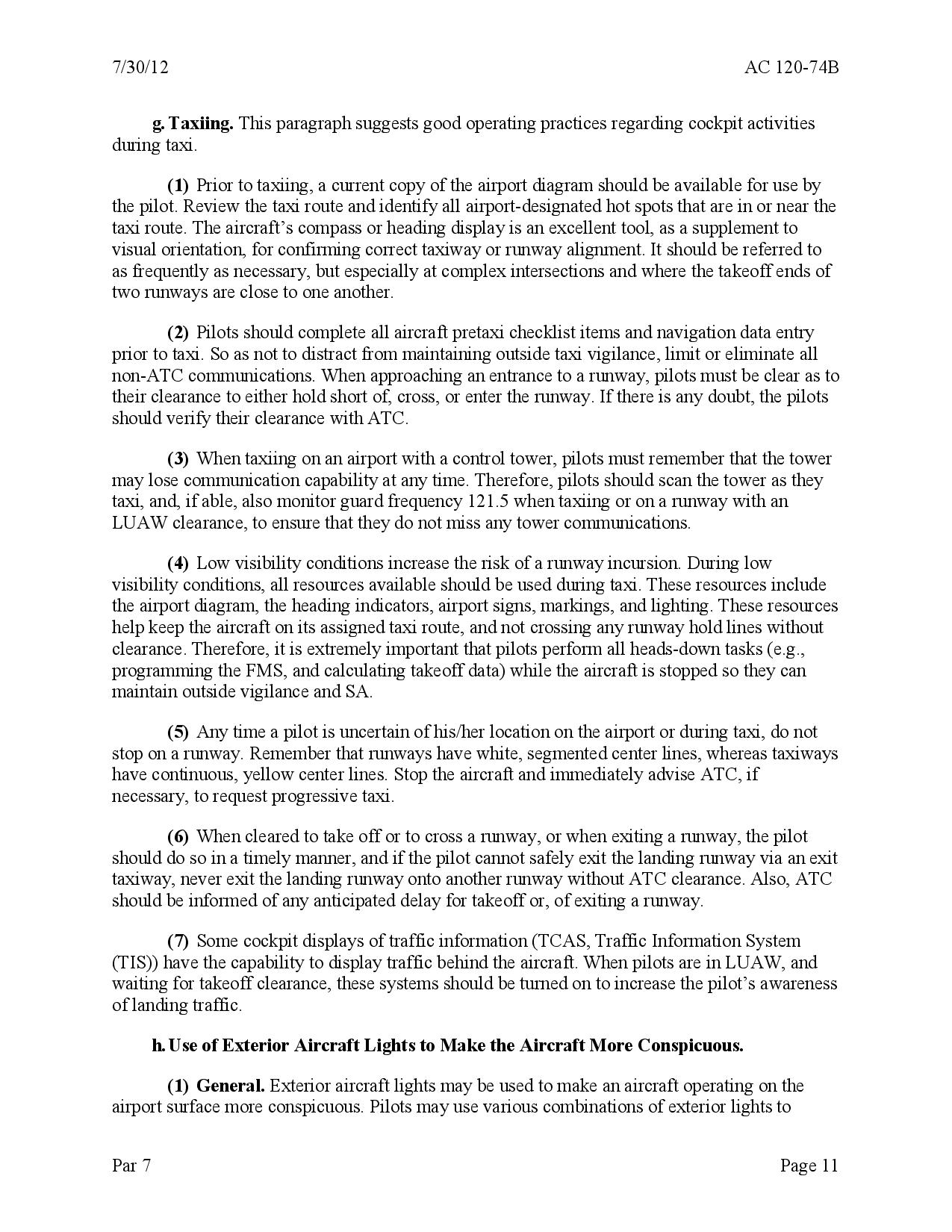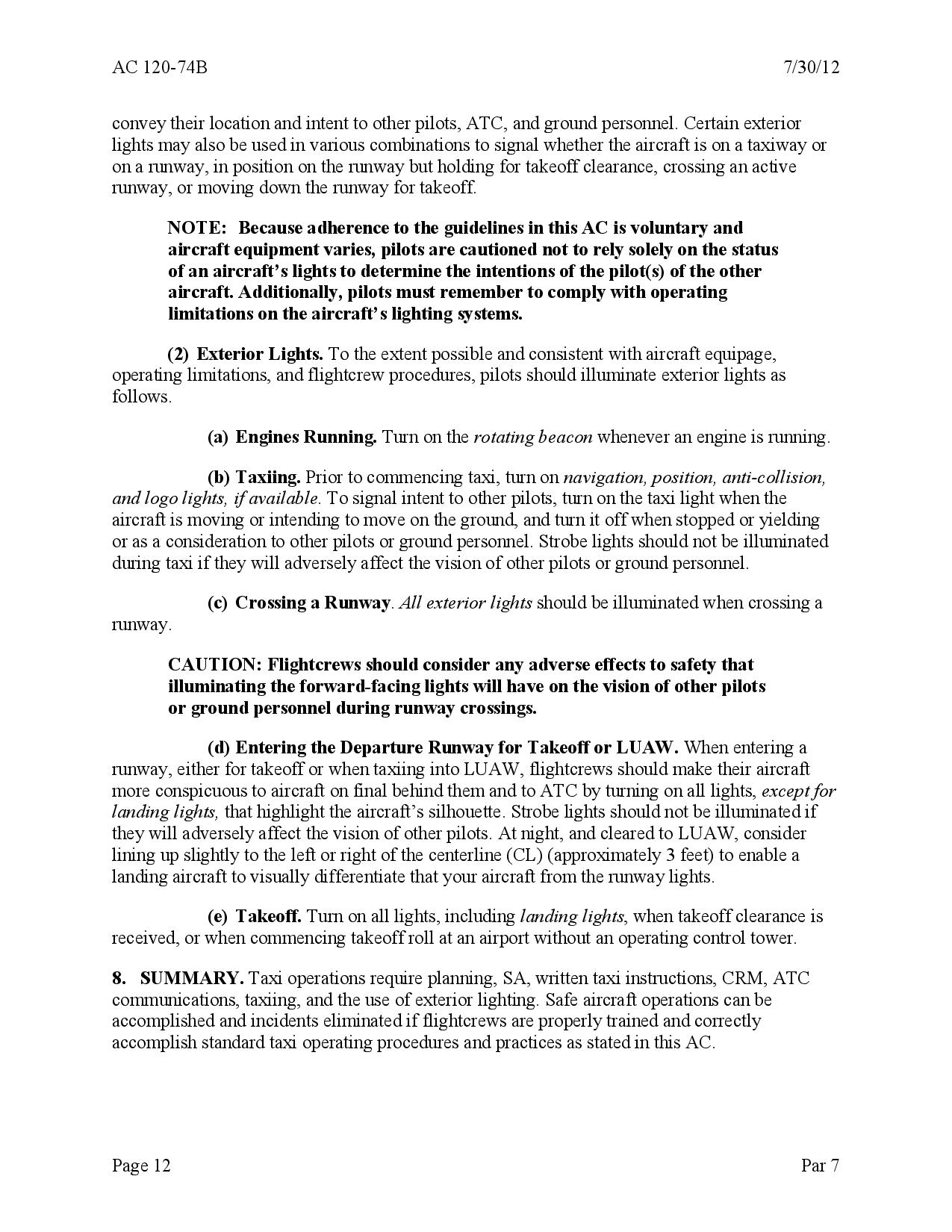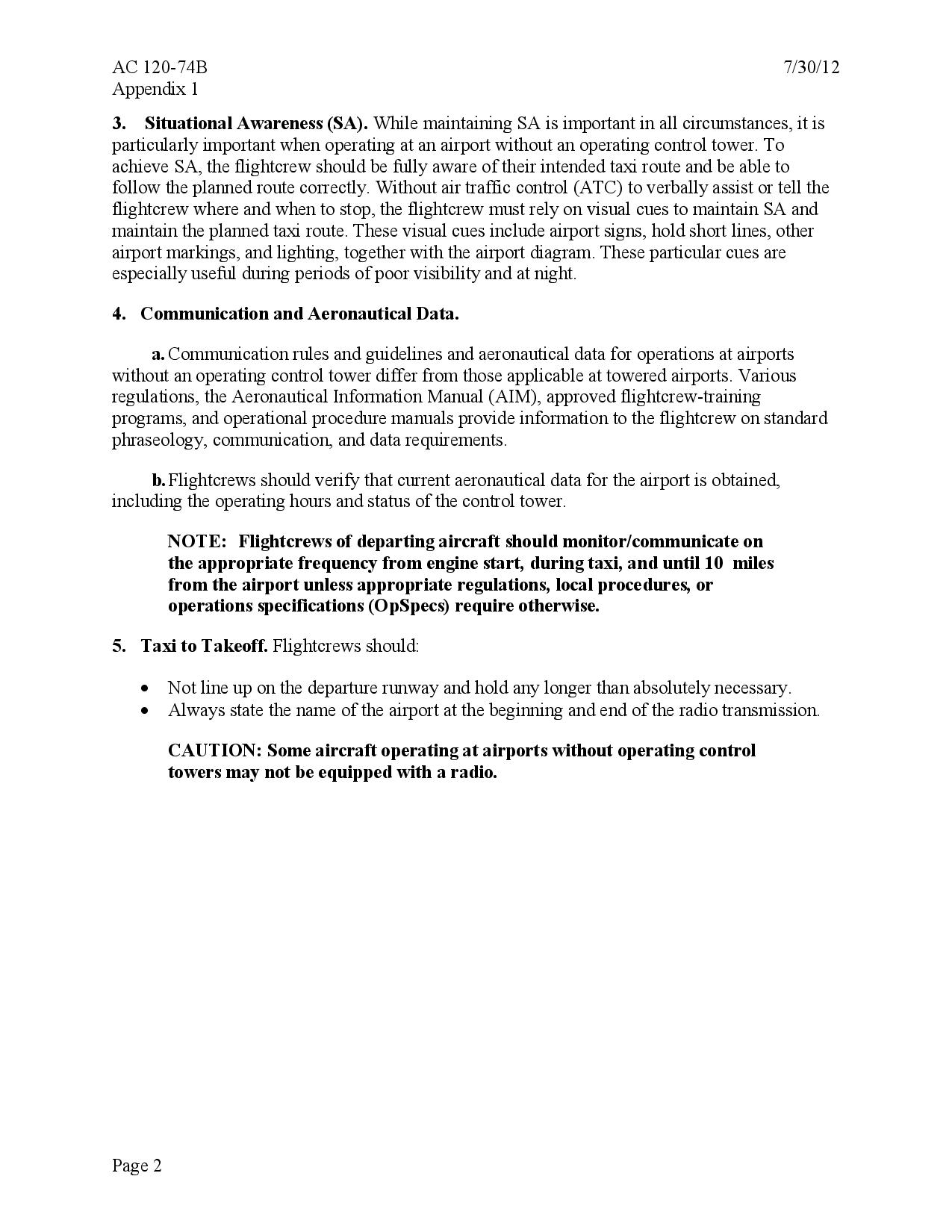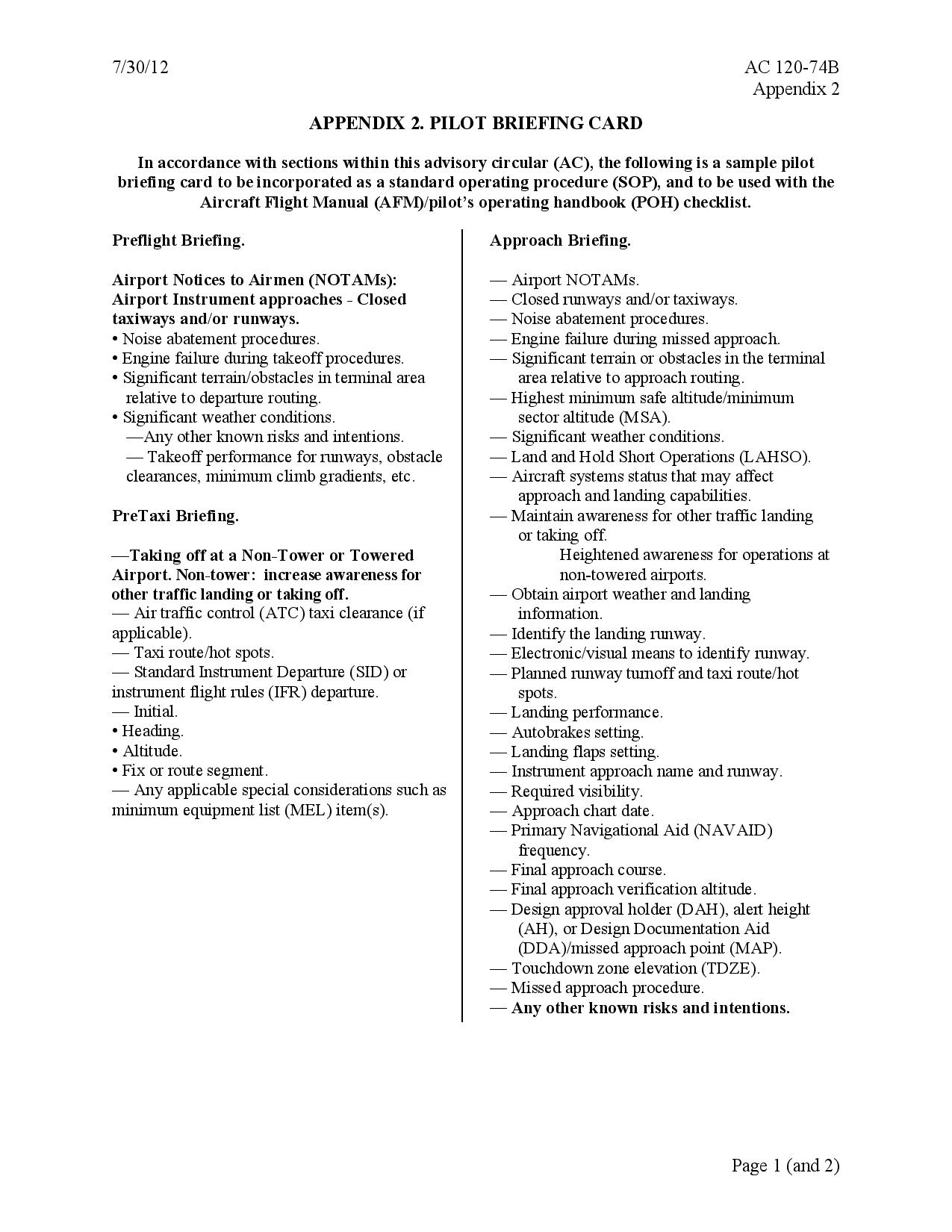From the article Advisory Circular (AC) 120-74B "Flightcrew Procedures During Taxi Operations" provided at the end: Answer the following questions in detail:
- Why have runway incursions become more hazardous now than in the past?
- Under paragraph 7 - FLIGHTCREW PROCEDURES - there are several subparagraphs, such as a. General, b. Planning, c. Situational Awareness. Identify and explain one recommendation from this section that might have the biggest impact on avoiding a runway incursion.
Note: The document from where the asked questions can be answered is as follows:
0 Advisory U.S. Department of Transportation . . I stairs\" Circular Subject: Parts 91, 121, 125, and 135 _ Date: 7130112 AC No: 120-748 Flightcrew Procedures During Taxr Initiated by: Change: Operations AFS200I800 1. PURPOSE. This advisory circular (AC) provides guidelines for the development and implementation of standard operating procedures (SOP) for conducting safe aircraft operations during taxiing to avoid causing a runway incursion. In accordance with Federal Aviation Administration (FAA) Order 7050.1, Runway Safety Program, the denition of a runway incursion is any occurrence at an aerodrome involving the incorrect presence of an aircraft, vehicle, or person on the protected area of a surface designated for the landing and takeoff of aircraft. It is intended for use by persons operating aircraft with two or more pilots on the ight deck under Title 14 ofthe Code of Federal Regulations (14 CFR) parts 91, 121, 125, and 135. The FAA recommends that these guidelines become an integral part of all SOPs, ight operations manuals (FOM), and formal ightcrew member training programs. The use of ightcrew SOPs should be emphasized and employed during all phases of ight, including ground operations. Appendices 1 and 2 of this AC contain examples of SOPs that are identical or similar to some SOPs currently in use. These appendices are not directive or prescriptive in nature and do not represent a rigid FAA view of Best Practices. SOPs may vary among eets and among certicate holders and may change over time. Operators may integrate the information contained in Appendices l and 2 into their eet-specic, route-specic, and equipment- specic operations and checklists. They are shown to denote how the SOPs and Be st Practices can be integrated into the context of specific ight operations. NOTE: Pilots operating aircraft single pilot under 14 part 91 and part 135, should refer to the current edition of AC 9173, Part 91, Part 135 SinglePilot, Flight School Procedures During Taxi Operations. 2. CANCELLATION. AC 120-74, Part 121, 125, and 135 Flightcrew Procedures During Taxi Operations, dated September 26, 2003, is canceled. 3. FOCUS. This guidance focuses on the development and use of mitigation procedures that will avoid a runway incursion and enhance safe taxi operations. 4. RELATED READING MATERIAL. The current versions of the following documents contain useful information regarding runway safety. You can find this and other ACs on the FAA's Web site at http://www.faa.gov/regulations_policies/advisory_circulars. Notices to Airmen (NOTAMs) are available at https://pilotweb.nas.faa.gov/Pilot Web. AC 120-74B 7/30/12 a. FAA ACs (current editions): . . AC 90-42, Traffic Advisory Practices at Airports Without Operating Control Towers. AC 90-66, Recommended Standard Traffic Patterns and Practices for Aeronautical Operations at Airports Without Operating Control Towers. . AC 120-57, Surface Movement Guidance and Control System. AC 120-71, Standard Operating Procedures for Flight Deck Crewmembers. b. Other Guidance: Aeronautical Information Manual (AIM). . Safety Alerts for Operators (SAFO) 11004, Runway Incursion Prevention Actions. . Pilot's Guide to Aeronautical Knowledge. National Aeronautics and Space Administration (NASA) Aviation Safety Reporting System (ASRS): http://asrs.arc.nasa.gov. Runway Status Light (RWSL) Program: http://www.faa.gov/air_traffic/technology/rwsl. c. Web Sites: . Aircraft Owners and Pilots Association (AOPA): http://www.aopa.org/asf/runway_safety. . . FAA Aviation News: http://www.faa.govews/safety_briefing/. FAA Runway Safety Program: http://www.faa.gov/airports/runway_safety. NOTAMs: https://pilotweb.nas.faa.gov/PilotWeb. 5. BACKGROUND. Runway incursions have sometimes led to serious accidents with significant loss of life. Although they are not a new problem, with increasing air traffic, runway incursions have been on the rise. One of the biggest safety concerns in aviation is the surface movement accident. As a direct result, the FAA has rapidly expanded the information available to pilots, including the addition of taxiway and runway information in FAA publications. The FAA has also implemented new procedures and created educational awareness programs for pilots, air traffic controllers, and ground operators. By focusing resources to attack this problem head-on, the FAA hopes to reduce and eventually eliminate surface movement accidents. This AC develops practical guidance toward the goal of increasing safety and efficiency of aircraft movement on the airport surface, while reducing the risk of runway incursions. a. Need for SOPs. Increased traffic and expansion at many airports create complex runway and taxiway layouts. This additional complexity has made airport surface operations more difficult and the potential for runway incursions more hazardous than in the past. To increase safety and efficiency, it is necessary to lessen the exposure to hazards and risks by holding the flightcrew's workload to a minimum during taxi operations. This can be accomplished through SOPs that direct the attention of the flightcrew to essential tasks while the aircraft is in motion. The development and formalized training of safe operating procedures during taxi operations should be implemented by each operator. Page 2 Par 47/30/12 AC 120-74B b. Development of SOPs. In developing these SOPs, it is important to consider flightcrew workload prior to takeoff and before landing. Considerations should be given to tasks that make up the normal workload of flightcrews, such as accomplishing checklists, configuring the aircraft for takeoff and landing, programming flight management systems (FMS), and managing communications with the carrier and air traffic control (ATC). The more complex the activities within the flight deck work environment, the greater the need for explicit, yet simple, and clear SOPs. The overall goal is for operators to develop standardized flightcrew procedures that will increase the flightcrew's situational awareness (SA) but will not increase their workload while the aircraft is taxiing 6. USE OF SOPs. The use of SOPs should be: Emphasized during the certification and proficiency training of all pilots; . Emphasized and used during all phases of flight, including ground operations; and, Evaluated during the flight review of all certificated pilots (refer to 14 CFR part 61, $$ 61.56 and 61.58). 7. FLIGHTCREW PROCEDURES. a. General. (1) The potential for runway incursions, incidents, and accidents can be reduced through adequate planning, coordination, and communication. The following guidelines are intended to help flightcrews cope more effectively with current airport conditions during taxi operations. All flightcrew members, regardless of whether they are designated as the pilot in command (PIC), second in command (SIC), or Flight Engineer (FE), will benefit from this guidance. (2) The guidelines are grouped into seven major categories, which expand on SAFO 1 1004: Planning, Situational Awareness, Written Taxi Instructions, Verbal Communication, ATC Communications, Taxi, and Exterior Lighting. Throughout this AC the term "pilot-not-flying" (PNF) is converted to "pilot monitoring" (PM). b. Planning. Thorough planning for taxi operations is essential for a safe operation. Flightcrews should plan for the airport surface movement portion of the flight just as they plan for the other phases of flight. Planning for taxi operations should be an integral part of the flightcrew's flight planning process and contains two main parts: review items and briefing items. (1) Review Items. Because of the constantly changing airport conditions and guidance information, flightcrews must to be aware of any changes made to regulatory and guidance information sources. The flightcrew also needs to have a thorough understanding of the items in the AC including, but not limited to, the following: (a) FAA initiatives are updating airport signage, markings, and lighting. Be sure you are thoroughly familiar with the updates. Also, there are initiatives that are taking place in the airport lighting, and it is important to know what the lighting is displaying to the flightcrews (e.g., Surface Movement Guidance and Control System (SMGCS) and RWSL). Par 5 Page 3AC 120-74B 7/30/12 (b) Without explicate ATC clearance, do not cross any runway hold short lines or instrument landing system (ILS) critical areas, if in use. (c) Review the current airport NOTAMs and automated terminal information service (ATIS) for runway and taxiway closures, construction activity, and other airport-specic risks. It is assumed that ATC has rsthand knowledge of runway and taxiway status. If a clearance is received to use a runway/taxiway that a NOTAM/ATIS broadcast indicates is closed, query the controller for verication of clearance. ((1) Review the current airport diagram, and hot spots, andif in use a published textual description of standard taxi routes to provide an overall \"big picture\" for the airport and it potential areas for a runway incursion. (2) Briefing Items. Just as ightcrews brief an instrument approach, it is critical for safety that a through brieng of taxi operations is conducted and understood by all crewmembers. Brieng of the following items should take place at a time when they are relevant and fresh in all crewmembers' memories (cg, before taxi and prior to initial descent). Conduct a brieng of all ightcrew members, and jump seaters as applicable, using guidance including, but not limited to, the following: (a) The ightcrew should brief the timing and execution of aircra checklists and company communications at the appropriate times and locations so the pilot who is not taxiing the aircraft can be available to participate in verbal coordination with the pilot who is taxiing the aircraft. This action is needed to conrm compliance with ATC taxi instructions at the appropriate times and locations. When brieng these tasks, ightcrews should also consider the anticipated duration of the taxi operation, the locations of hot spots/complex intersections and runway crossings, and the visibility along the taxi route. To reduce pilot workload and heads-down time during taxi, it is recommended that, if conditions permit, ightcrews conduct predeparture checklists at the gate including setting the takeoff ap setting, when the aircraft is stopped, or while taxiing straight ahead on a taxiway without complex intersections and hot spots. (b) Remind all cockpit occupants of the importance of maintaining a sterile cockpit, but encourage the ability to speak up if anyone sees a potential conict or interprets a clearance differently. Encourage jump seaters to monitor communications. (c) When operating an aircraft that does not have a door between the ight deck and the passenger compartment, the pilot may need to ask passengers to maintain a sterile cockpit and refrain from unnecessary conversation from the time the preight preparations begin until the time the aircraft is clear of the terminal area and at cruising altitude. The same procedure should be followed on arrival, from the time landing preparations begin until the aircraft is safely stopped at the terminal. ((1) Brief all pilots to display the current airport diagram to follow the progress of the taxi operation. (Refer to the NOTE below.) Page 4 Par 7 7/30/12 AC 120-74B NOTE: Under parts 121, 125, and 135, there are explicit requirements for either the use or availability of \"aeronautical charts.\" A type of \"aeronautical chart,\" as defined in the AIM, is an \"airport diagram.\" Part 125, 125.215, and part 135, 135.83, require \"pertinent aeronautical charts\" to be accessible to the pilot at the pilot station and to be used by the pilots. Part 121, 121.549, requires \"aeronautical charts\" to be available on the aircraft; however, many operators require \"airport diagrams\" to be available for use by ightcrews. (e) Brief the expected taxi route to include any hold short lines and runways to cross, hot spots, and any other potential conicts. Once taxi instructions are received, the pretaxi route should be reviewed and monitored. It is essential that any changes to the taxi route be understood by all crewmembers. CAUTION: A potential pitfall of pretaxi and prelanding planning is setting expectations and then receiving different instructions from ATC. Flightcrews need to follow the clearance or instructions that are actually received, and not the ones they expected to receive. (1) Address previous experience at the airport and unusual procedures or techniques that are not typically used on an everyday basis, such as different pushback procedures or communication requirements. (g) Identify critical locations on the taxi route, (e.g., hot spots/complex intersections, crossing intervening runways, entering and lining up on the runway for takeoff, and approaching and lining up on the runway for landing) where verbal coordination between the PIC and the SIC is important to avoid a runway incursion. (h) Brief single-engine taxi (if applicable), including allowing enough time to complete all required checklists without any crewmember feeling rushed. Do not accept any ATC clearance if it appears that you will be unable to properly complete all required checklist items. (i) Before initial taxi, once the aircraft is clear of equipment and personnel and has been released for taxi from the gate, complete as many checklist items as possible, such as: setting the aps (many crewmembers use the technique of keeping their hand on the ap handle upon selection, until all indications show selected setting), trim, loading nal weight, and balance data. In addition, upon landing, no items should be changed or moved until the entire aircraft is clear of the active runway's hold short line (e. g, changing radio frequencies and repositioning aps, trim, and speedbrakes). NOTE: Due to operations, such as deicing procedures, or contaminated surfaces, it may not be advantageous to complete the above listed items before initial taxi. In this case these items should be accomplished according to company set procedures, at a time and location to allow completion of all required checklist items without rushing or a hurried pace. Par 7 Page 5 AC 120-74B 7/30/12 (j) During low visibility operations brief the requirements and special considerations such as: the low visibility taxi chart, if published for the airport, and be alert if ATC states to hold short of an ILS critical area holding line. (k) Though the use of cell phones and other electrical devices are prohibited during commercial use of aircraft, use of cell phones or personal devices can be a valuable asset such as, communicating with maintenance, ATC, as well as obtaining realtime weather. Typically these uses should only be allowed on inactive taxi areas when stopped, or parked with engines shut down. It is important to assure that everyone present in the aircraft have their phones and devices turned of during taxi operations to prevent any distractions. c. Situational Awareness (SA). When conducting taxi operations, pilots need to be aware of their proximity to other aircraft and vehicles moving on the airport. This SA is comprised of, but not limited to, knowledge of the aircraft's precise position. Flightcrews should use a \"continuous loop\" process to actively monitor and update their progress and location during taxi. This includes knowing the aircraft's present location and mentally calculating the next location on the route that will require increased attention (e. g, a turn onto another taxiway, an intersecting mnway, or hot spots). As the taxiing progresses, ightcrew members should verbally share relevant information with each other. SA is enhanced by understanding the ATC clearance issued to you, other aircraft, and vehicles in order to avoid potential conicts. In addition to the above, specic pilot actions to mitigate causing a runway incursion include, but are not limited to, the following: (1) Have a current airport diagram readily available for reference and check the assigned taxi route against the diagram with the heading indicator or compass, paying special attention to any hot spots and complex intersections. While maintaining outside vigilance, pilots must follow the aircraft's progress on the airport diagram to ensure that the pilot taxiing the aircraft is following the instructions received from the ATC. (2) Pilot(s) must monitor the taxi clearance and re ad back all hold short instructions. Verbalizing hold short instructions is a method to ensure that pilot(s) have a clear understanding of the intended taxi plan and do not cross any runway hold short lines without ATC clearance. The SIC will request conrmation from the PIC if not received. (3) Know and use all of the visual aids available at the airport, such as the signs, markings, and lighting as well as ATC (ground and/or tower), to follow the assigned taxi route. NOTE: A fundamental concept of improving monitoring is realizing that many pilot errors occur when one or more pilots are offfrequency or doing heads down work, such as programming an FMSIGlobal Positioning System (GPS). Therefore, perform all high workload duties before beginning to taxi. Otherwise, performing these duties during taxi can have significant safety implications. (4) Prior to entering or crossing any runway, the pilot must be positive that ATC has cleared them to cross the runway. Pilots should scan the full length of the runway and scan for Page 6 Par 7 7/30/12 AC 120-74B aircraft on nal approach or landing rollout, and if there is any confusion about the scan results, the pilot should stop taxiing the aircra and ask ATC to clarify this situation. (5) When approaching an entrance to a runway, both pilots will ensure compliance with hold short or crossing clearance. Furthermore, bring the aircraft to a complete stop, or be in a phase of taxiing that has no risk of a runway incursion before continuing with operational duties and checklists. CAUTION: Exercise increased awareness when taxiing in between active parallel runways. (6) Be especially vigilant if another aircraft that has a similar call sign is on frequency. Care should be taken to avoid inadvertently executing a clearance or instruction for another aircraft. (7) If the pilot becomes disoriented, never stop on a runway and initiate communications with ATC to regain orientation. (8) Pilots should be especially vigilant when instructed to taxi and \"Line Up and Wait\" (LUAW). Trafc Alert and Collision Avoidance System (FCAS)/trafc advisory systems (TAS) should be turned on in order obtain awareness of any aircraft that may be landing on your ninway. When taxiing onto a ninway, either at the end of the runway or at an intersection, scan the full length of the runway and scan for aircraft on nal approach or landing rollout. NOTE: ATC should be contacted anytime there is a concern about a potential conflict. (9) If a pilot has been instructed to LUAW without being advised of the reason/condition (wake turbulence, trafc on intersecting runway, etc.) or the reason/ condition is not clearly visible (e. g, another aircraft is has landed or is taking off on the same runway), the pilot should expect a communication from ATC within 90 seconds. If the pilot does not receive a communication from ATC within 90 seconds of the LUAW clearance, the pilot should query ATC. Flightcrews should be especially vigilant when instructed to LUAW, particularly at night or during periods of reduced visibility. NOTE: If radio communications are unusually quiet, or if radio problems or stuck microphone are suspected, contact ATC, and look for light gun signals. (10) Flightcrews should use caution after landing on a runway that intersects another runway, or on a runway where the exit taxiway is in close proximity to another runway's hold short line. (11) After landing, ensure that the entire aircraft, including the tail section, has crossed over the respective landing runway's hold short line. This will ensure that the entire aircraft is clear of the respective runway safety area. If you are constrained from clearing the landing nmway by an adjacent parallel nlnway hold short line, stop and immediately advise ATC. Par 7 Page 7 AC 120-74B 7/30/12 (12) After landing at a non-towered airport, or at an airport where the control tower is closed, remember that not all aircra are radio-equipped; therefore, before entering or crossing a runway, listen on the appropriate frequency (common trafc advisory frequency (CTAB) for inbound aircraft information and scan the full length of the runway, including the nal approach and departure paths of the runway(s) you intend to enter or cross. (13) After landing, nonessential communications and nonessential ightcrew actions should not be initiated until clear (on the inbound (terminal) side) of all runways in accordance with sterile cockpit procedures (e. g., changing radio frequencies and repositioning aps, trim, and speedbrakes). (14) During landing, do not accept last-minute turnoff instructions from ATC unless you clearly understand the instructions and are certain that you can safely comply. I]. Use of Written Taxi Instructions. At many airports, taxi clearance can be very complex. The clearance can involve numerous turns, as well as intermediate hold short of other runways. Written taxi instructions can be used as a reference for reading back the instructions to ATC and as a means of reconrming the taxi route and any restrictions. This will mitigate any misunderstanding or forgetting of any part of the taxi clearance, which can lead to a runway incursion. (1) While written taxi instructions are a good operating technique, common sense and exibility should be used in determining the crew's need for them at a specic airport. For example, if the departure runway is very near the aircra parking location, or if the crew has used the same taxi route numerous times, it may only be necessary to record the basic elements of the taxi clearance. However, when the taxi instructions are complex or the crew is unfamiliar with the airport layout, a detailed transcription of all instructions is desirable. Additionally, individual pilots may choose to develop a set of symbols and shorthand notations that allow them to clearly record and later recall key items in the taxi instructions. As a technique, some pilots enter taxi instructions into the ight management computer (FMC) scratchpad. (2) Examples: 0 The ATC clearance is: N123 taxi 9R via Bravo, Echo, Juliet, Hold Short 4L at Echo. o The ATC clearance written: 9R B E J @ E. Where the clearance limit of 4L at Echo is circled. I The ATC clearance may be entered into an FMC or other database scratchpad: 9R BEJ/4L E. 0 Where the forward slash /, which represents the Hold Short line, proceed to the clearance limit of 4L at Echo. 0 Symbols: Hold Short: (0, Cross (X). Then from the airport diagram, on a taxiway to make a left turn'_,| right turn Ip Page 8 Par 7 7/30/12 AC 120-74B e. Flight Deck Verbal CommunicationlCrew Resource Management (CRM). (1) It is essential that all misunderstandings or disagreements be resolved to the satisfaction of all ightcrew members before taxiing the aircraft. It is the verbal aspect of this coordination that is most signicant. It is not enough to assume that all ightcrew members have heard and understood instructions correctly. A common understanding can be enhanced by one ightcrew member repeating the instructions verbally and getting agreement on the content and intent from the other ightcrew member(s). Any persistent disagreement or uncertainty among crewmembers should be resolved by contacting ATC for clarication. (2) When ightcrew members verbally conrm their understanding of the instructions, they then have a chance to discover and correct any misunderstandings and thus prevent hazardous situations from developing. This verbal coordination/agre ement should be accomplished at the following times. (a) When ATC issues a clearance for an arrival or departure, the ightcrew should refer to the airport diagram and conrm and verbalize the assigned runway and taxi route, including any instructions to hold short of, or cross, a runway. If there is any doubt, speak up and resolve the uncertainty. (b) When it becomes necessary for a ightcrew member to stop monitoring any ATC frequency to prepare the aircraft for takeoff or landing, he or she should tell the other ightcrew memberCs) when stopping and resuming the monitoring of the ATC frequency. They should also reiterate any upcoming hold short instructions or clearances that could be misinterpreted. An example may include: \"I'm heads-down, right turn ahead at Alpha,\" or \"I'm back, any changes?\" Time away from monitoring ATC should be avoided with complex taxi routing or crossing of runways. Any instructions or information received or transmitted during that ightcrew member's absence from the ATC frequency should be briefed and reviewed upon his or her return. NOTE: Hea ds down time should only take place when the aircraft is taxiing straight ahead or stopped, or after it has landed and is clear of the active runway, With no upcoming hold short lines or hot spots. (c) At complex intersections, the flightcrew should verbally coordinate to be sure that the intersection is correctly identied, and conrmed, using the airport diagram and the heading indicator, so that the aircraft transitions through the intersection to the correct taxiway. (d) When approaching any hold short line, verbalize \"approaching (specic runway number) hold short line. Before crossing any hold short line, the ightcrew should visually scan to the left and to the right, including the full length of the runway and its approach paths, and coordinate verbally (e. g., \"clear right/left\" or that the scan area is not clear). (e) Before entering a runway for takeoff, the ightcrew should verbally coordinate to ensure correct ap setting, identication of the nrnway, compass heading, FMC entry, and receipt of the proper ATC clearance to use that runway. Similar verication should be performed during approach to landing. Par 7 Page 9 AC 120-74B 7/30/12 (1) When ATC issues landing instructions, the ightcrew should coordinate verbally and agree on the runway assigned by ATC, the upcoming assigned exit, and any restrictions, such as hold short points of an intersecting runway and the aircraft's parking area after landing. (g) If a change in plans develops, such as a return to the gate, a heightened awareness must be maintained by all crewmembers so as to avoid unexpected or out-of-the-ordinary ow. Be aware of each crewmember's workload, such as dealing with company procedures, passengers, running late, and even personal issues. f. ATClPilot Communication. Radio communication is the primary way that pilots and ATC communicate. The safety and efciency of taxi operations at airports with operating control towers depend on this \"communication loop.\" Controllers use standard phraseology and require readbacks and other responses from the ightcrew in order to ensure that clearances are understood. It is the pilot's responsibility to advise ATC when they do not understand an ATC clearance. The ightcrew should respond by using standard phraseology and the aircraft's complete call sign or registration number. Regulatory requirements, the AIM, approved ight crewmember training programs, and operational manuals provide information for ightcrews on standard ATC phraseology and communications requirements. The following are elements for clear communications. (1) Flightcrews should use stande ATC phraseology at all times in order to facilitate clear and concise ATC/flightcrew communications. Be aware of the need for complete understanding of accents, terminology, and International Civil Aviation Organization (ICAO) procedures while operating at foreign airports. (2) State your position whenever making initial contact with any tower or ground controller, regardless of whether your position was previously stated to a different controller. (3) Focus on the ATC clearance. Pilots should not perform any nonessential tasks while communicating with ATC. Given that many nmway incursions occur even after the pilot reads back the hold short instruction, pilots should develop a technique to remind themselves to hold short of a hold line. For example, place something on an instrument knob or on top of the instrument panel, or hang it on the magnetic compass or on the control yoke. (4) Pilots are required to read back all clearances. Ensure that you include the complete call sign and nmway designator when reading back a clearance to enter a specic nmway, hold short of a runway, or taxi to LUAW. Avoid using \"Roger\" or \"Wilco\" in these instances. (5) Actively monitor the assigned tower frequency or CTAF for potential conicts involving their runway, or a crossing runway, when holding in position for takeoff and when on nal approach. If not in use for a higher priority communication, the additional radio, if equipped, should be set to monitor guard frequency as a backup to stuck microphone or lost communications. (6) Read back all takeoff and landing clearances, including the runway designator, and if applicable, state \"intersection departure.\" Page 10 Par 7 7/30/12 AC 120-74B g. Taxiing. This paragraph suggests good operating practices regarding cockpit activities during taxi. (1) Prior to taxiing, a current copy of the airport diagram should be available for use by the pilot. Review the taxi route and identify all airport-designated hot spots that are in or near the taxi route. The aircraft's compass or heading display is an excellent tool, as a supplement to visual orientation, for conrming correct taxiway or runway alignment. It should be referred to as frequently as necessary, but especially at complex intersections and where the takeoff ends of two runways are close to one another. (2) Pilots should complete all aircraft pretaxi checklist items and navigation data entry prior to taxi. So as not to distract from maintaining outside taxi vigilance, limit or eliminate all non-ATC communications. When approaching an entrance to a runway, pilots must be clear as to their clearance to either hold short of, cross, or enter the runway. If there is any doubt, the pilots should verify their clearance with ATC. (3) When taxiing on an airport with a control tower, pilots must remember that the tower may lose communication capability at any time. Therefore, pilots should scan the tower as they taxi, and, if able, also monitor guard frequency 121.5 when taxiing or on a runway with an LUAW clearance, to ensure that they do not miss any tower communications. (4) Low visibility conditions increase the risk of a runway incursion. During low visibility conditions, all resources available should be used during taxi. These resources include the airport diagram, the heading indicators, airport signs, markings, and lighting. These resources help keep the aircraft on its assigned taxi route, and not crossing any runway hold lines without clearance. Therefore, it is extremely important that pilots perform all heads-down tasks (e.g., programming the FMS, and calculating take off data) while the aircraft is stopped so they can maintain outside vigilance and SA. (5) Any time a pilot is uncertain of his/her location on the airport or during taxi, do not stop on a runway. Remember that runways have white, segmented center lines, whereas taxiways have continuous, yellow center lines. Stop the aircraft and immediately advise ATC, if necessary, to request progressive taxi. (6) When cleared to take off or to cross a runway, or when exiting a runway, the pilot should do so in a timely manner, and if the pilot cannot safely exit the landing runway via an exit taxiway, never exit the landing runway onto another runway without ATC clearance. Also, ATC should be informed of any anticipated delay for takeoff or, of exiting a runway. (7) Some cockpit displays of trafc information (TCAS, Trafc lnforrnation System (T 18)) have the capability to display trafc behind the aircraft. When pilots are in LUAW, and waiting for takeoff clearance, these systems should be turned on to increase the pilot's awareness oflanding trafc. 11. Use of Exterior Aircraft Lights to Make the Aircraft More Conspicuous. (1) General. Exterior aircraft lights may be used to make an aircraft operating on the airport surface more conspicuous. Pilots may use various combinations of exterior lights to Par 7 Page 11 AC 120-74B 7/30/12 convey their location and intent to other pilots, ATC, and ground personnel. Certain exterior lights may also be used in various combinations to signal whether the aircraft is on a taxiway or on a runway, in position on the runway but holding for takeoff clearance, crossing an active runway, or moving down the runway for takeoff. NOTE: Because adherence to the guidelines in this AC is voluntary and aircraft equipment varies, pilots are cautioned not to rely solely on the status of an aircraft's lights to determine the intentions of the pilot(s) of the other aircraft. Additionally, pilots must remember to comply with operating limitations on the aircraft' s lighting systems. (2) Exterior Lights. To the extent possible and consistent with aircraft equipage, operating limitations, and ightcrew procedures, pilots should illuminate exterior lights as follows. (a) Engines Running. Turn on the rotating beacon whenever an engine is running. (b) Taxiing. Prior to commencing taxi, turn on navigation, position, antic ollision, and logo lights, if available. To signal intent to other pilots, turn on the taxi light when the aircraft is moving or intending to move on the ground, and turn it off when stopped or yielding or as a consideration to other pilots or ground personnel. Strobe lights should not be illuminated during taxi if they will adversely affect the vision of other pilots or ground personnel. (c) Crossing a Runway. All exterior lights should be illuminated when crossing a runway. CAUTION: Flightcrews should consider any adverse effects to safety that illuminating the forward-facing lights will have on the vision of other pilots or ground personnel during runway crossings. (d) Entering the Departure Runway for Takeoff or LUAW. When entering a runway, either for takeoff or when taxiing into LUAW, ightcrews should make their aircraft more conspicuous to aircraft on nal behind them and to ATC by turning on all lights, except for landing lights, that highlight the aircraft's silhouette. Strobe lights should not be illuminated if they will adversely affect the vision of other pilots. At night, and cleared to LUAW, consider lining up slightly to the left or right of the centerline (CL) (approximately 3 feet) to enable a landing aircraft to visually differentiate that your aircraft from the runway lights. (e) Takeoff. Turn on all lights, including landing lights, when takeoff clearance is received, or when commencing takeoff roll at an airport without an operating control tower. 8. SUMMARY. Taxi operations require planning, SA, written taxi instructions, CRM, ATC communications, taxiing, and the use of exterior lighting. Safe aircraft operations can be accomplished and incidents eliminated if ightcrews are properly trained and correctly accomplish standard taxi operating procedures and practices as stated in this AC. Page 12 Par 7 7/30/12 AC 120-74B 9. APPENDICES TO THIS AC. Appendix 1 contains SOP items and Best Practices that are very similar to SOPs/Best Practices currently in use in the air carrier segment of the industry. Appendix 2 contains an SOP Template for Ground Operations and the Prevention of Runway Incursions. These appendices are not directive or prescriptive in nature and do not represent a rigid FAA view of Best Practices. SOPs may vary among aircraft and operators and may change over time. Operators and individuals may use the information contained in the appendices to integrate the basic tenets into their aircraft-specic, route-specic, and equipment-specic operations and checklists. They are shown to denote how the SOPs and Be st Practices can be integrated into the context of specic ight operations. ORINGINAL SIGNED by (71 M. a? W /s/ ' John M. Allen, Director, Flight Standards Service for Par 9 Page 13 (and 14) 7/30/12 AC 120-76B Appendix 1 APPENDIX 1. AIRPORT SURFACE OPERATIONS AT NON-TOWERED AIRPORTS AND AIRPORTS WHEN THE TOWER IS CLOSED Runway Incursion Avoidance Standard Operating Procedures (SOP) Items NOTE: For more information about operations at non-towered airports, refer to the current versions of Advisory Circular (AC) 9042, Traffic Advisory Practices at Airports without Operating Control Towers and AC 9066, Recommended Standard Traffic Patterns and Practices for Aeronautical Operations at Airports without Operating Control Towers. 1. General. The following procedures are in addition to those that are applicable at towered airports. The absence of an operating airport trafc control tower (ATCT) creates a need for increased vigilance on the part of the ightcrew operating at those airports. There are also specic communications procedures that differ from those used at airports with control towers. Planning, clear communications, and enhanced situational awareness SA during airport surface operations will reduce the potential for surface incidents at airports without an operating control tower. This appendix focuses on those aspects of taxi operations that are unique to airports without an operating control tower and will not be repeated in such detail as the information covered in other sections of this AC. 2. Planning. a. Planning taxi operations at an airport without an operating control tower is similar to planning taxi operations at an airport with an operating tower. However, ightcrews must remember that some airports have part-time operational control towers. When planning to y into or out of such an airport, ightcrews must be absolutely certain of the tower's operational status before conducting any operaons. If the status is in doubt, they should attempt contact on the tower's frequency. b. In addition to the information provided for operations at airports with an operating control tower, pilots should consider the following when operating at an airport without an operating control tower: (1) Familiarize themselves with the local trafc pattern direction and check their specic pattern altitude. During calm wind conditions, be aware that ight operations may occur at more than one runway at the airport. (2) Aircraft may be using an instrument approach procedure (IAP) to runways other than the runway in use for visual ight rules (V FR) operations. The instrument approach runway may intersect the VFR runway. It is also possible that an instrument arrival may be made to the opposite end of the runway from which a takeoff is being made. (3) Be sure that the taxi plan is understood. (4) Prior to taxi, communicate your intentions on the common trafc advisory frequency (CTAF), and listen for other aircraft operating on, to, and from the airport. Page 1 AC 120-748 7/30/12 Appendix 1 3. Situational Awareness (SA). While maintaining SA is important in all circumstances, it is particularly important when operating at an airport without an operating control tower. To achieve SA, the ightcrew should be fully aware of their intended taxi route and be able to follow the planned route correctly. Without air trafc control (ATC) to verbally assist or tell the ightcrew where and when to stop, the ightcrew must rely on visual cues to maintain SA and maintain the planned taxi route. These visual cues include airport signs, hold short lines, other airport markings, and lighting, together with the airport diagram. These particular cues are especially useful during periods of poor visibility and at night. 4. Communication and Aeronautical Data. a. Communication rules and guidelines and aeronautical data for operations at airports without an operating control tower differ from those applicable at towered airports. Various regulations, the Aeronautical Information Manual (AIM), approved ightcrew-training programs, and operational procedure manuals provide information to the ightcrew on stande phraseology, communication, and data requirements. b. Flightcrews should verify that current aeronautical data for the airport is obtained, including the operating hours and status of the control tower. NOTE: Flightcrews of departing aircraft should monitorlcommunicate on the appropriate frequency from engine start, during taxi, and until 10 miles from the airport unless appropriate regulations, local procedures, or operations specications (0 pSpecs) require otherwise. 5. Taxi to Takeoff. Flightcrews should: 0 Not line up on the departure runway and hold any longer than absolutely necessary. 0 Always state the name of the airport at the beginning and end of the radio transmission. CAUTION: Some aircraft operating at airports without operating control towers may not be equipped with a radio. Page 2 7/30/12 AC 120-74B Appendix 2 APPENDIX 2. PILOT BRIEFING CARD In accordance with sections within this advisory circular (AC), the following is a sample pilot briefing card to be incorporated as a standard operating procedure (SOP), and to be used with the Aircraft Flight Manual (AFM)/pilot's operating handbook (POH) checklist. Preflight Briefing. Approach Briefing. Airport Notices to Airmen (NOTAMs): Airport NOTAMs Airport Instrument approaches - Closed Closed runways and/ or taxiways. taxiways and/or runways. - Noise abatement procedures. . Noise abatement procedures. Engine failure during missed approach. . Engine failure during takeoff procedures. Significant terrain or obstacles in the terminal . Significant terrain/obstacles in terminal area area relative to approach routing relative to departure routing - Highest minimum safe altitude/minimum . Significant weather conditions. sector altitude (MSA). -Any other known risks and intentions. Significant weather conditions. Takeoff performance for runways, obstacle Land and Hold Short Operations (LAHSO). clearances, minimum climb gradients, etc. Aircraft systems status that may affect approach and landing capabilities. PreTaxi Briefing. Maintain awareness for other traffic landing or taking off. -Taking off at a Non-Tower or Towered Heightened awareness for operations at Airport. Non-tower: increase awareness for non-towered airports. other traffic landing or taking off. -Obtain airport weather and landing - Air traffic control (ATC) taxi clearance (if information. applicable) Identify the landing runway. - Taxi route/hot spots. Electronic/visual means to identify runway. Standard Instrument Departure (SID ) or Planned runway turnoff and taxi route/hot instrument flight rules (IFR) departure. spots. - Initial. - Landing performance. . Heading. Autobrakes setting. . Altitude. Landing flaps setting. Fix or route segment. Instrument approach name and runway. Any applicable special considerations such as - Required visibility. minimum equipment list (MEL) item(s) Approach chart date. - Primary Navigational Aid (NAVAID) frequency. - Final approach course. Final approach verification altitude. Design approval holder (DAH), alert height (AH), or Design Documentation Aid (DDA)/missed approach point (MAP). Touchdown zone elevation (TDZE). Missed approach procedure. Any other known risks and intentions. Page 1 (and 2)
